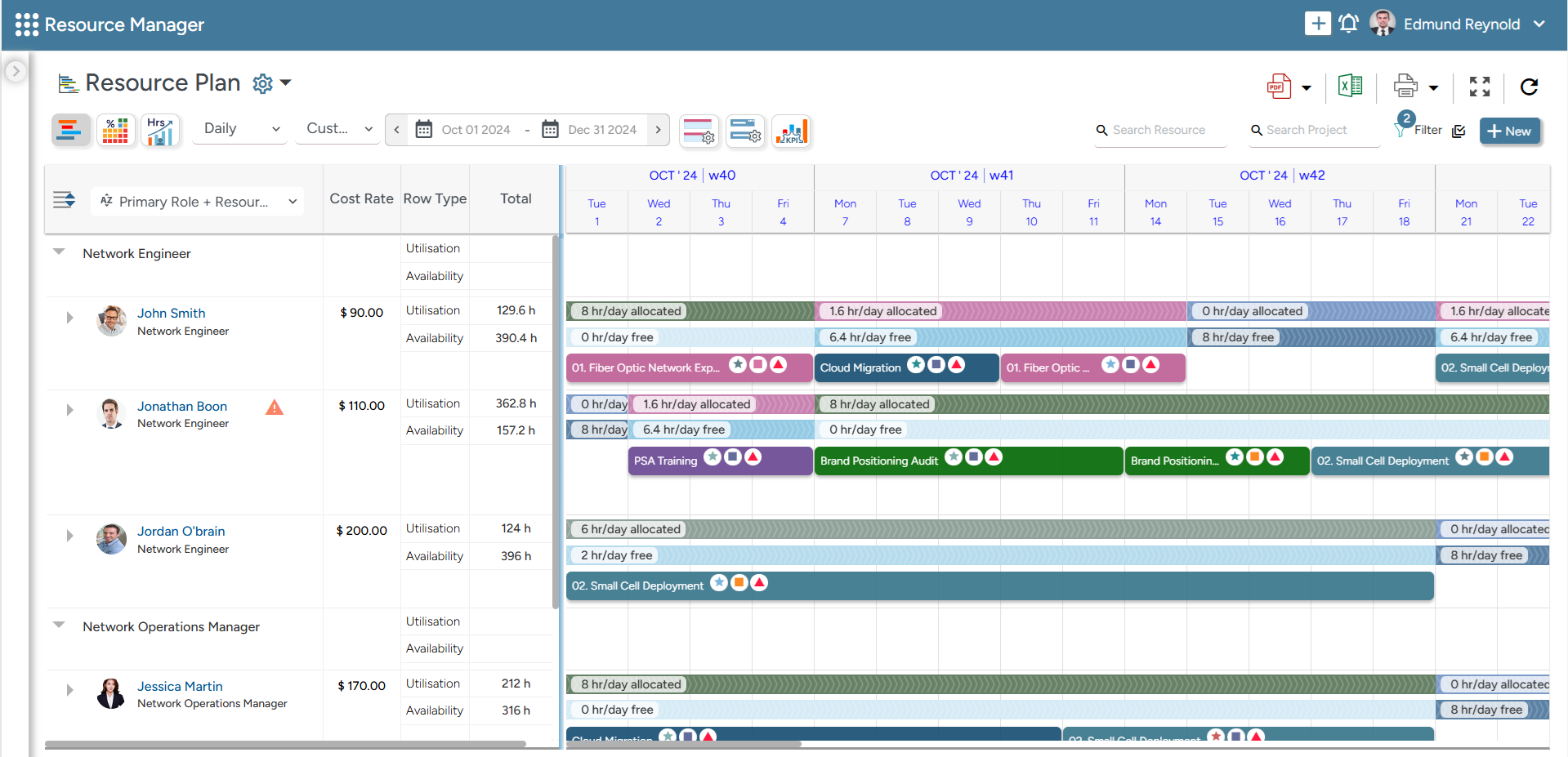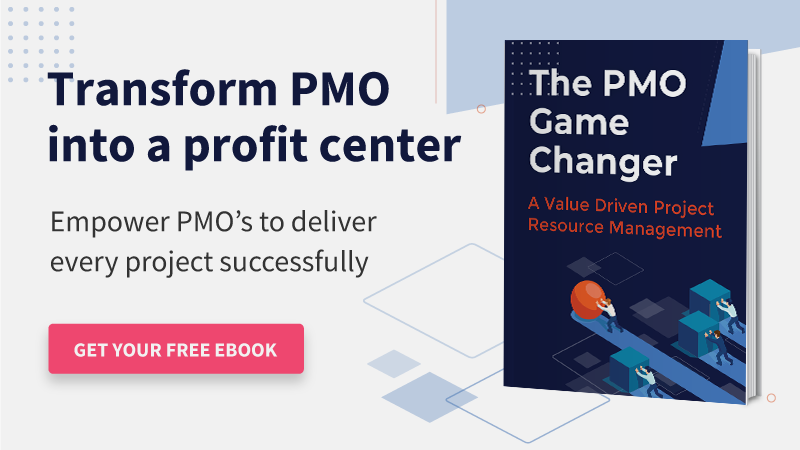In project-based organizations, projects are often part of a larger ecosystem, where their success depends on various interdependencies—shared resources, overlapping timelines, and interconnected deliverables. When project interdependencies are managed well, it can drive successful business outcomes. In contrast, if they are not managed well, it can cause workflow disruptions, delays, and costly missteps that jeopardize the overall success of the project portfolio.
Hence, understanding interdependencies is crucial for keeping teams aligned and ensuring project success. By implementing the right frameworks and tools, organizations can manage interdependencies and ensure that every project delivers value as intended and achieves their goals.
In this article, we will dive into project dependencies, their types, different scheduling categories, and effective strategies to manage them. Let’s get started!
What are Project Interdependencies?
Project interdependencies refer to the relationships between tasks, deliverables, or entire projects wherein one can impact another’s progress, or their order of occurrence can substantially influence the project portfolio’s outcome. These dependencies can be sequential, wherein one task must be completed before the next begins, or they may involve shared resources or technologies that bind multiple projects together.
However, if not appropriately managed, all these project interdependencies can lead to discrepancies and conflicts among teams. To prevent this, organizations leverage Project Interdependency Management (PIM), a structured approach that provides managers with processes, tools, and techniques to identify, analyze, track, and manage various project interdependencies cohesively
Moreover, project interdependency can be measured using two primary methods:
- Dependency Matrices: A 2-dimensional grid that depicts the bi-directional dependencies of a project within a portfolio. This technique produces a visual way of understanding sequential project interdependence.
- Network Mapping: A 3D visual technique that uses nodes and arrows to show multi-dimensional, complex dependency across multiple and large projects. This method uses graphical models to map interdependency project networks
Now that we’ve understood the definition, let’s look at an example.
Project Interdependencies Example
Below mentioned are two examples demonstrating project interdependencies:
Example 1: House Construction Project
A clear example of project task interdependency can be seen in building a house. For instance, plumbing work must be installed before the walls can be sealed. This means the plumbers must complete their tasks—such as laying pipes, fitting fixtures, and ensuring proper connections—before the construction resources can seal the walls. This demonstrates a sequential interdependency within the project.
Example 2: Software Development Project
Consider a scenario where a software development project depends on completing a cloud infrastructure setup. The cloud infrastructure must be fully configured, tested, and secured before the software can be accessible. Any delays in the infrastructure setup can push back the software release timeline. This highlights cross-project interdependency requiring continuous alignment and communication
Now, let’s explore the different types of project interdependencies.
Types of Project Interdependencies
Project interdependencies can be categorized into two types: internal and external.
Internal Dependency
In project management, an “internal dependency” refers to the relationship between tasks within the same project, where one task must be completed before another can begin. Since these dependencies exist within the project team’s control, they are easier to manage, schedule, and adjust as needed.
Now that we have a clear understanding of internal project interdependencies, let’s explore their types, which include:
Resource Interdependencies
Resource interdependencies refer to the shared service model of critical resources between two projects. It arises due to limited resource availability and high demands for the same resource across multiple organizational projects. This type of dependency is typically managed at resource manager levels.
Read More: What is Resource Availability in Project Management, and Why Does It Matter?
Technology Interdependencies
Technology interdependencies occur when multiple projects rely on shared technology, systems, or infrastructure to function effectively. This interdependency facilitates managers’ leveraging one project’s technical knowledge to another project, enhancing technical and cross-departmental collaboration across multiple projects.
For example, developing a new version of computers depends on another project of developing operating systems designed to run on a 64-bit processor.
Technical Interdependencies
In technical interdependency, the output generated by one project serves as the critical input of another project. These dependencies are often tied to the underlying technology, architecture, or systems being used. Thus, such interdependencies demand close coordination, timely communication, and version control.
For example, a consumer data collection project captures customer information, while a Business Intelligence (BI) project transforms this data into insights for future reference.
Read More: 5 Benefits of Using Business Intelligence in Resource Management
Knowledge-based Interdependencies
This interdependency occurs when experience, insights, and learnings from one project contribute to the success of other ongoing projects within the same portfolio. Project managers can proactively apply lessons learned from previous projects to drive innovation and improve efficiency across similar future opportunities.
For example, a smartphone company leverages user feedback and technical insights from one product release to enhance its features and design of the next models.
External Dependency
External dependency refers to a task or a project that relies on a third party or external factor to proceed. Unlike internal dependencies, these are outside the project team’s control, making them more challenging to manage. Examples include waiting for government approvals, vendor deliveries, or regulatory compliance.
Now that we clearly understand external dependency, let’s explore one of its key types.
Market Interdependencies
Market interdependencies occur when external market forces influence a project’s progress, direction, or success. This includes industry trends, customer demand, competitor actions, and the overall economic environment. Thus, project teams need to stay agile and monitor the market closely.
For example, a tech company developing a new smartwatch must adjust its features and pricing after a competitor launches a similar product.
Let us now dive deep into the scheduling categories of project interdependencies:
Read More: Mastering Project Resource Management: A Comprehensive Guide
Scheduling Categories of Project Dependencies
Managers must formulate a project schedule before resource scheduling to identify the order of tasks. Most commonly, there are four scheduling categories of dependency in project management. These are:
Finish-to-Start (FS)
In project management, a finish-to-start (FS) dependency means that one task cannot begin until the preceding task is completed. This relationship is called a “finish-start” or “finish-begin” dependency. For example, designers must complete the wireframing in a software development project before developers begin the development work.
Start-to-Start (SS)
A Start-to-Start (SS) dependency means that one task (the “successor”) can only begin once another task (the “predecessor”) has started. For instance, excavation of the land and foundation pouring in construction project must begin around the same time to maintain workflow.
Finish-to-Finish (FF)
A finish-to-finish (FF) dependency means that Task B cannot finish until Task A has been completed, implying that one task’s completion is contingent upon another’s completion. Consider a project where Task A is “Write the report,” and Task B is “Submit the report.” In an FF dependency, Task B can only be completed once Task A is finished.
Start-to-Finish (SF)
It is the most uncommon dependency type, often mistaken for the Finish-to-Start type. A start-to-finish (SF) dependency means a task (successor) cannot finish until another task (predecessor) begins. For example, the account manager can only invoice the client (task B) after initiating the product’s delivery (Task A).
Next, let’s explore why Project Interdependency Management (PIM) is essential.
Read More: What is Project Scheduling, and Why is it Important?
Why is Project Interdependency Management (PIM) Important?
Project Interdependency Management (PIM) plays a vital role in ensuring that complex, multi-task, or multi-project environments run smoothly and efficiently. When interdependencies are not tracked or managed effectively, even a small delay in one task can have a ripple effect, disrupting schedules and escalating budgets.
Consider a scenario where your team works on a high-priority software development project. The schedule has been carefully designed, and the designers, developers, and testers are booked for the two-month-long development & testing phase. But now, the project schedule is slipping from the developer’s end, and their tasks are not completed per the predefined timelines.
With a lack of real-time updates of this dependency, the QA engineers/testers would show up and log hours without productive output. It would blow up project costs, cause delays, and significantly affect the entire project. This is where Project Interdependency Management becomes critical.
PIM practice provides a structured approach with formal documentation to identify and manage dependencies across tasks and teams. Thus, it allows project managers to:
- Proactively track and communicate the project’s status
- Anticipate and mitigate risks related to scope, schedule, and cost
- Optimize resource utilization and reduce inefficiencies
- Ensure timely and high-quality project delivery
Given the importance of PIM, here’s a detailed explanation of managing project interdependencies.
Read More: What is Resource Utilization? A Complete Guide to Improve Business Efficiency
How to Manage Project Dependencies?
Here are a few steps that managers can take to ensure that they adequately manage the impact of project interdependencies. Let’s take a look at how you can do this.
Identify all Project Dependencies
For better planning managers can assess various project interdependencies and document them in the Project Initiation Document (PID). Conducting brainstorming sessions with project stakeholders will identify and assess potential interdependencies across multiple projects. This proactive approach minimizes risks, ensures smooth workflow transitions, and enhances overall project efficiency.
An example of a project dependency can be creating a training video for end-users, which relies on completing module preparation. Before the training session can be conducted, all necessary materials, including instructional content, guides, and presentations, must be fully developed. Without these resources, the training video would lack the essential information for end-users to understand the software.
Assess the Impact
Even minor delays in one task can trigger chain reactions that affect multiple aspects of the project. Therefore, managers must analyze how each dependency influences the overall project flow. For this, they can evaluate key factors such as resource availability and bandwidth, project budget and potential overruns, external vendor timelines, and approval cycle.
After assessing the impact, dependencies can be prioritized based on their level of risk, urgency, and complexity. High-risk dependencies can be addressed first by allocating buffer resources or adopting an alternative workflow. Besides this, it is also important to communicate project interdependencies clearly across teams to ensure alignment with the project goal and avoid any last-minute surprises.
Read More: How to Develop an Effective Project Budget in 8 Simple Steps?
Hold a Dependency Workshop
A dependency workshop is crucial for projects with multiple resources or overlapping work across teams. This collaborative session brings together key stakeholders, team leads and managers to openly discuss, document, and address all potential project interdependencies across tasks, teams and parallel projects
The primary goal of dependency workshop is to identify critical interdependencies that may impact timelines, resource allocation or deliverables. Moreover, it also helps in clarifying ownership and accountability for each dependency, resource conflicting priorities or scheduling overlaps. Thus, it promotes cross-functional alignment and fosters project planning.
Read More: Top 14 Project Management Methodologies: Tips to Choose the Right One
Consider the Risks/ Constraints
According to Gartner, “Failing to understand risk interdependencies can result in seemingly unrelated risk events triggering more severe risk events throughout the organization.”
To ensure effective risk management practices, project managers can analyze project interdependencies early in the project life cycle to identify potential risks. They can detect delays before they escalate by assessing task relationships, resource availability, and scheduling constraints. Early risk identification allows for flexible solutions like resource reallocation, timeline adjustments, or contingency planning.
For example, your team can create an app for a client, and you might rely on the first project to reuse the code for this project. However, there is a risk that the first project work will not be finished on time, the code will not be reusable, and you will have to start from scratch. These risks are driven by dependency and are crucial to manage. Failing to do so will lead to time and budget overruns.
Read More: Enterprise Risk Management Framework: 8 Core Components
Continuously Monitor & Control
Identifying and documenting the dependency log is essential for managers to monitor and control successful project delivery. Using an intuitive project management tool, managers can specify all project interdependencies and regularly monitor a preferred project schedule’s progress. Additionally, assessing the dependencies and constraints also illustrates the health of each project.
For example, in a construction project, the manager can use a project management tool to document project interdependencies, such as the need to complete the foundation before structural work begins. Further, by maintaining a dependency log, they can track progress to ensure each phase aligns with the preferred schedule. Additionally, regular monitoring can identify delays or resource constraints, allowing timely adjustments.
Let us now learn how project resource management software can help make project interdependencies crystal clear.
How can Modern Project Resource Management Software Help?
With an advanced project resource management tool, managers can efficiently manage the project interdependencies and ensure timely delivery. Here’s how:
- The tool’s all-in-one resource planner enables managers to slice and dice the resource plan across various dimensions like role, experience, expertise, location, cost, etc. Further, the tool’s 360-degree visibility provides detailed insights into the project tasks, ensuring optimal resource allocation and timely completion.

SAVIOM’s All-in-One Resource Planner gives complete insight into resource-centric attributes like role, expertise, location, experience, and cost.
- The intuitive Gantt Chart feature visually displays project timelines, task interdependencies, and milestones, which allows managers to spot any inefficiencies beforehand.

SAVIOM’s Gantt Chart enables users to view and manage tasks, timelines, deliverables, and resource allocation seamlessly on a single platform
- Now, its early warning system provides managers with alerts during instances of overloading, double-booking etc., preventing scheduling conflicts.
- The tool’s task management feature enables managers to ensure that skilled resources are allocated to every task. This ensures dependencies are finished on stipulated time.
- The real-time BI reports provide granular insights into resource availability, utilization, and other project resource metrics, allowing seamless project execution and preventing dependency conflicts.
![]()
SAVIOM’s Utilization Tracking Dashboard with color-coded heatmaps provides a quick overview of resource workload.
- The actual vs. forecast time report compares the planned timelines against the actual data recorded during project execution and helps managers ensure no deviation.
Conclusion
Project interdependencies are critical to PPM practice and impact scheduling and resource activities. Managers can use the project management tool and a work breakdown structure (WBS) to help their team understand interdependency levels. The project interdependency management approach also helps eliminate blockages in the project management system by enhancing the project workflow.
How do you manage various project interdependencies in your organization?
The Glossary
Read More: Glossary of Resource Workforce Planning, Scheduling and Management













